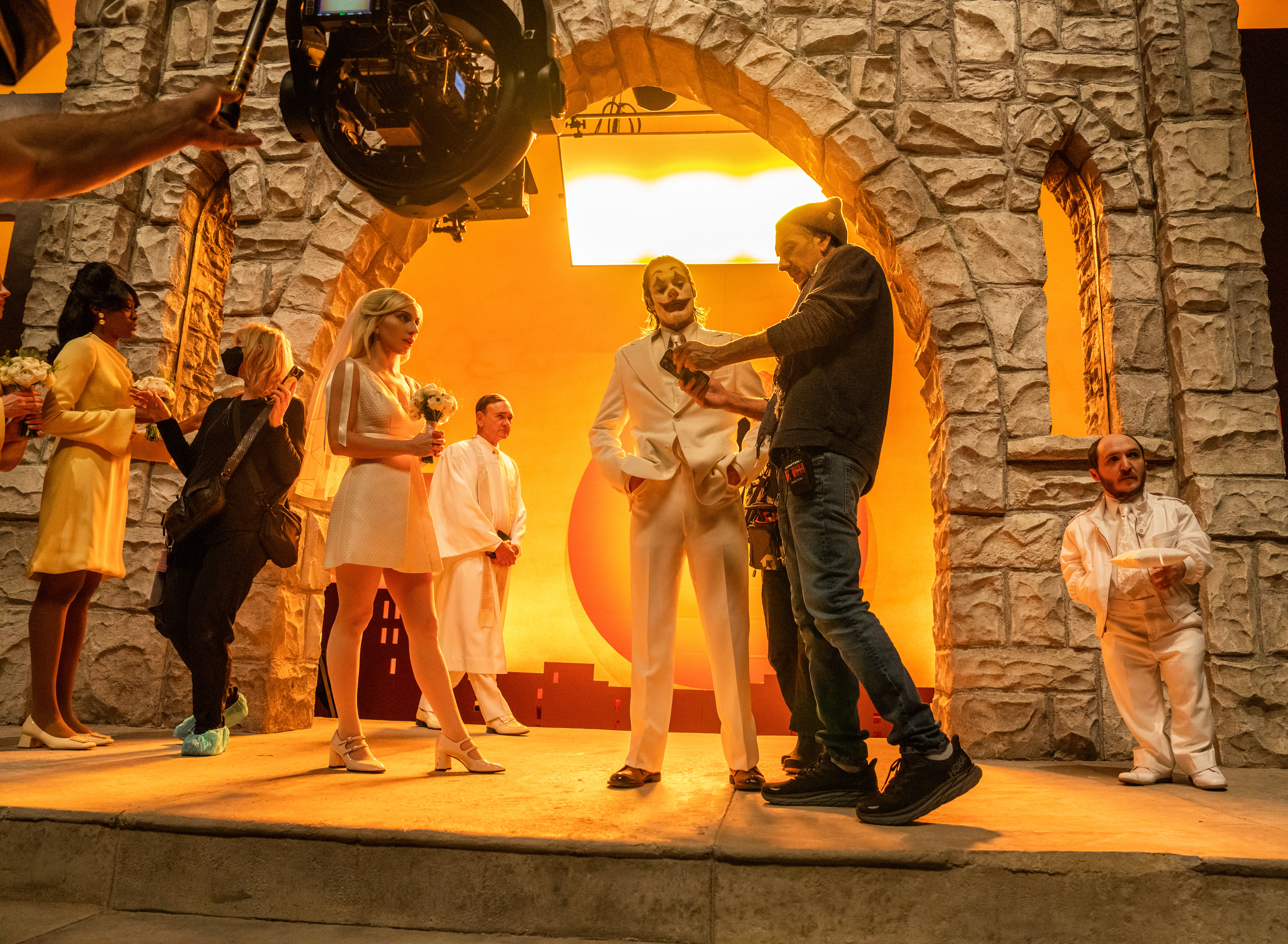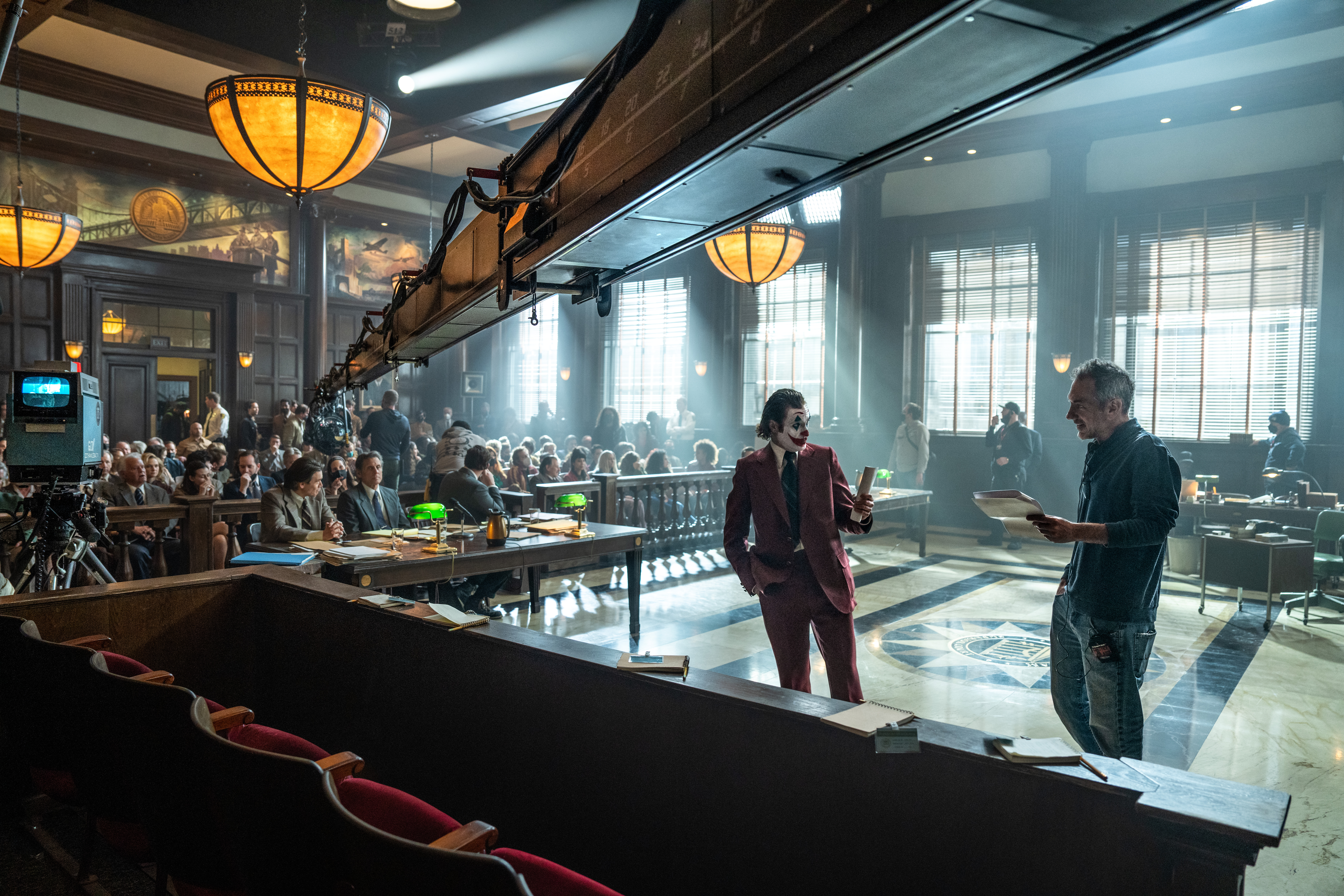
As a longtime fan of musical theater and someone who has spent countless hours belting out show tunes in my living room, I found “Folie à Deux” to be a rather disappointing venture into the world of song and dance. Having grown up with animated Disney movies where villains often steal the show with their elaborate musical numbers, it was disheartening to see such potential go largely untapped in this film.
The first thing you need to know about “Joker: Folie à Deux” is that it’s not a musical.
Initially, the introduction displays posters of “Modern Times,” “Pal Joey,” and “Shall We Dance.” In a scene, Arkham Asylum inmates are seen watching the 1953 film “The Band Wagon” where Arthur Fleck (Joaquin Phoenix) mimics Fred Astaire’s performance. However, he becomes irritated when Lee Quinzel (Lady Gaga) declines to watch with him. Later, they both perform the climactic song “If My Friends Could See Me Now” from the “Sweet Charity” musical. At one instance, the Joker also demonstrates tap dancing skills.
But tuneful moments and a few moves do not a musical make. And that disconnect between what the film appears to be and what it actually manages to pull off is at the core of its failure. Compared to Warner Bros.’ 2019 original, which won two Academy Awards and grossed more than $1 billion worldwide, director Todd Phillips’ sequel doesn’t have the courage of its own — or any great musical‘s — convictions. With an opening weekend domestic box office take of $40 million and a Cinemascore of D, it seems like audiences sniffed that out for themselves.
Make no mistake, though: It’s not that the musical genre — often erroneously reduced to smiley song-and-dance routines and happily-ever-after endings — can’t be as gritty and dark as “Joker” would require (see “Sweeney Todd: The Demon Barber of Fleet Street,” “Assassins,” “Cabaret”). Or that it can’t tackle touchy topics like mental illness (“The Light in the Piazza,” “Anyone Can Whistle”), societal rejection (“Be More Chill,” “Oklahoma!”), drug dependency (“Next to Normal,” “Jagged Little Pill”), sexual assault (“Spring Awakening,” “The Color Purple”) or suicidal ideation (“Fun Home,” “Dear Evan Hansen”).

Musicals, contrary to what some critics might suggest, are remarkably versatile in structure. Characters in a musical may express their emotions through song instead of straightforward dialogue when that’s not enough to truly convey their feelings. Also, they might burst into song as if it’s just another way of communicating within their unique world. Even dedicated realists can create musicals, using a score that’s part of the story itself and weaving the narrative around a concert or a performance.
Regardless of the specific setup, there’s one consistent truth: a musical progresses its narrative by treating sincerely the foundational elements such as songwriting, singing, arranging music, dance, etc. “Folie à Deux,” which occasionally resembles and even sounds like a musical, seems to approach everything with a lack of seriousness – except perhaps itself.
To put it simply, the term “Folie à Deux” oversimplifies the storytelling potential of jukebox musicals. These musicals skillfully weave popular tunes into fresh narratives. By leveraging the audience’s recognition of these melodies, jukebox musicals also have the chance to offer a surprising twist on well-known songs. For instance, “& Juliet” creatively reinterprets Britney Spears’ “I’m Not a Girl, Not Yet a Woman” to portray a character’s journey with non-binary identity, while “Tina: The Tina Turner Musical” ingeniously uses the seductive song “Private Dancer” from 1984 to depict Tina Turner’s desperate turn to performing in Las Vegas bars.
In contrast, the majority of songs in “Folie à Deux” seem to serve no clear purpose, providing minimal fresh ideas or character development. Apart from Lee mentioning “(They Long to Be) Close to You” as a witty depiction of her fixation on Arthur’s alter ego, it appears that the film merely mentions tracks instead of using them to narrate its stories; this is similar to listing course materials and claiming you’ve finished the course.
In addition to the film, the performances by both Phoenix and Gaga are puzzlingly delivered. To convey Arthur’s romantic longing for Lee, Phoenix sings “For Once in My Life” and “Bewitched (Bothered and Bewildered)” – songs often sung with the enthusiasm of a smitten Tom Cruise leaping on Oprah Winfrey’s couch. However, instead of displaying his impressive vocal skills as he did in his Academy Award-winning role as Johnny Cash in “Walk the Line,” Phoenix delivers these songs disappointingly softly, which stands out even more against the rich orchestral accompaniment.
It might be due to Arthur’s weakened condition, which is unlike his powerful Joker persona, or perhaps because they were required to sing live on set. Regardless, many memorable stage performances such as “Flowers” from “Hadestown” and “I Dreamed a Dream” from “Les Miserables,” have a soft start that reflects the characters’ vulnerable states. These tender renditions resonate emotionally and sound appealing to the ear.
In a singular solo appearance, Phoenix portrays the Joker, aptly singing “The Joker” from the 1964 musical “The Roar of the Greasepaint – The Smell of the Crowd.” However, it’s somewhat underwhelming as it comes 90 minutes into the courtroom drama and is still held back by vocal limitations. This seems unusual since popular animated Disney movies often give villains the most impressive musical numbers, allowing them to be flamboyant and ostentatious, much like the Joker in the 2019 film.
However, unlike the first movie where the villain performed an unforgettable dance routine on Guason Stairs, this sequel doesn’t feature him. Instead, all the musical sequences are depicted as dreams. The character Arthur/Joker might possess exceptional performing skills, but we only see these performances in dream scenes – a treat for viewers who appreciate his imagined talent!
In much the same way, Lady Gaga’s extraordinary vocal abilities often go unnoticed – a move that seems questionable given she is one of the most renowned pop stars globally and has garnered two Grammy Awards for her collaborative work with Tony Bennett on The Great American Songbook. Interestingly, Gaga recently launched “Harlequin,” an album with a more theatrical feel, where she covers various movie songs herself, regardless of which character sang them originally. I’m torn between whether Gaga’s jazzy rendition of “Get Happy,” her guitar-driven version of “The Joker,” and her original tracks “Folie à Deux” and “Happy Mistake” are a comfort after watching the film or an additional layer of emotion to the experience.

“The strange choice made by ‘Folie à Deux’ in abbreviating most musical sequences is a clear indication of misunderstanding these pieces. This hasty editing significantly truncates decades-old compositions, often before they reach their emotional and musical climaxes. The motivation for this recurring action remains unclear and creates as much disruption as abruptly ending an intense fight scene or a heartfelt monologue. If these scenes were originally filmed in their entirety, removing the final bars would have reduced the overall running time, but might have left viewers even more perplexed.
In my critique as a movie enthusiast, I must admit that Lady Gaga’s film “Folie à Deux” seems to grapple with the musical genre rather than fully embracing it. At a Venice Film Festival press conference, Gaga herself acknowledged this unique approach, stating, “The way we handle music in this film is exceptionally delicate and multifaceted.” She went on to clarify that while it might not fit traditional definitions of a musical, the use of music serves as an essential tool for characters to articulate emotions beyond what dialogue could convey. In essence, music becomes a powerful means of expression when words fall short.
Phillips expressed in an interview that he doesn’t want his movie to be compared to ‘In the Heights’, where a character from a store starts singing and everyone moves to the street, even including police dancing. He clarified that he has great admiration for ‘In the Heights’, but he wants his film to stand on its own.
In essence, Gaga mentioned to Vogue that regarding the out-of-tune notes, “Both Arthur and Lee aren’t professional singers, and it shouldn’t seem like they are.” Phoenix further stated, “I motivated her (Gaga) to sing in a less-than-perfect manner.
If Phillips had truly created a bold “Joker” musical and promoted it enthusiastically, it would have been a daring move deserving of praise, even if it didn’t meet expectations. However, when Arthur pleads with Lee in a scene to “stop singing” and “just converse with me,” I found myself sharing his sentiment.
Good thing it’s not a musical.
Read More
- Clash Royale Best Boss Bandit Champion decks
- Vampire’s Fall 2 redeem codes and how to use them (June 2025)
- Mobile Legends January 2026 Leaks: Upcoming new skins, heroes, events and more
- World Eternal Online promo codes and how to use them (September 2025)
- How to find the Roaming Oak Tree in Heartopia
- Clash Royale Season 79 “Fire and Ice” January 2026 Update and Balance Changes
- Best Arena 9 Decks in Clast Royale
- Clash Royale Furnace Evolution best decks guide
- FC Mobile 26: EA opens voting for its official Team of the Year (TOTY)
- Best Hero Card Decks in Clash Royale
2024-10-07 21:31